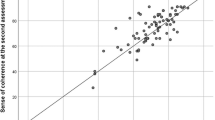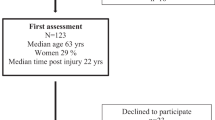Abstract
Study design:
Cross-sectional pilot study.
Objectives:
To explore correlates of body image among women with spinal cord injury (SCI), within the framework of Cash's cognitive behavioral model of body image.
Setting:
Hamilton, Ontario, Canada.
Methods:
Women with SCI (N=11, 64% with tetraplegia) reported their functional and appearance body image (Adult Body Satisfaction Questionnaire). A 3-day recall of leisure time physical activity (LTPA), three measures of body composition (that is, weight, waist circumference, body fat) and several demographic variables were assessed as potential correlates.
Results:
Appearance satisfaction was negatively correlated with all three measures of body composition and positively correlated with years postinjury. Functional satisfaction was positively correlated with years postinjury, and negatively correlated with various LTPA variables.
Conclusion:
Functional and appearance body image may improve with time following SCI. Body composition may impact satisfaction with physical appearance for some women. The negative relationship between LTPA and functional satisfaction merits further examination, as functional dissatisfaction may motivate individuals to engage in certain types and intensities of LTPA. Correlates of body image differ between appearance and functional satisfaction. Future research should examine appearance and functional satisfaction separately among women with SCI.
Similar content being viewed by others
Introduction
Given the drastic changes to function and appearance following spinal cord injury (SCI), individuals with SCI may be at risk for body image disturbance.1 Compared to the general population, people with SCI experience an increased prevalence of health problems.2 Given that body image disturbance can further jeopardize health,3 understanding factors related to body image is an important step toward improving health within this population.
Cash's cognitive behavioral model of body image4 is a well developed paradigm for examining body image. The model considers various social (for example, culture), cognitive (for example, internalized dialogue) and behavioral (for example, self-regulatory behavior) variables, which are hypothesized to be related to the development of an individual's body image. Cash's model4 is far too complex to consider all constructs within a single research investigation. As such, we examined two aspects of Cash's cognitive behavioral model of body image4 among women with SCI, including physical characteristics (that is, body composition), and leisure time physical activity (LTPA; that is, a self-regulatory strategy) in relation to body image. We chose to examine these two variables as both physical characteristics and LTPA behavior may be affected by SCI and are modifiable. Demographic characteristics were also examined.
Women with SCI have not been considered independently from men in the sparse SCI-body image literature. We are not aware of any studies that have focused exclusively on body image in women with SCI. The paucity of body image research in the SCI literature and the underrepresentation of women calls for body image research focused on women with SCI.
The relationship between body image and LTPA has been extensively researched in the general able-bodied population.3 A single study in the SCI population suggests that LTPA may also be related to body image for people with SCI. Compared to nonexercising controls, exercisers with SCI reported improved satisfaction with physical function and appearance following an exercise intervention.5 However, this study did not take gender differences into account and therefore does not provide any insight regarding body image and LTPA in women with SCI per se.
Women with SCI may be at particular risk for body image disturbance as body concerns are generally more prevalent among women than men.6 Very little is known about body image among women living with SCI. Further, previous research has focused almost exclusively on satisfaction with appearance while overlooking the importance of function for people living with SCI. Appearance and function are independent aspects of body image.6 As such, this exploratory study examines correlates of satisfaction with appearance and function within the framework of Cash's model.4 In particular, this pilot study examines body image in relation to two modifiable factors, body composition and LTPA, among women with SCI.
Materials and methods
Body image
The Adult Body Satisfaction Questionnaire,6 was used to measure body image. Participants rated satisfaction with appearance (for example, weight) and function (for example, arm strength) on a 7-point scale (−3 (very dissatisfied) to +3 (very satisfied)). Appearance and function items were averaged to create separate subscale scores.
Body composition
Following previously established protocol,7 weight was measured using the Health O Meter's 2450KL (Pelstar LLC, Bridgeview, IL, USA) wheelchair scale, waist circumference was measured at the lowest rib while the participant was in a supine position, and body fat percentage was measured using bioelectrical impedance analysis (RJL Systems Biolectrical Body Composition Analyzer Quantum II, Clinton Twp, MI, USA).
Leisure time physical activity
LTPA was measured using the Physical Activity Recall Assessment for People with SCI8 (PARA-SCI). Participants reported LTPA performed over the previous 3 days by intensity (that is, heavy, moderate, mild) and type (that is, aerobic and resistance). Average daily minutes of LTPA were calculated for each type and intensity.
Methods
Participants were 11 women (mean age=39) from the substudy component of the Study of Health and Activity in People with Spinal Cord Injury (SHAPE SCI).8 Participants had incurred SCI at least 12 months before recruitment, were ⩾18 years of age, and relied on an assistive device for mobility (Table 1). PARA-SCI telephone protocol8 was followed for collecting LTPA data. Within 2 weeks of the telephone interview, body composition, body image and demographic data were collected during a home visit. We certify that all applicable institutional and governmental regulations concerning the ethical treatment of human volunteers were followed.
Results
Mean body image scores are in Table 1. Spearman's rank-order correlations were calculated as various data were non-normally distributed, and thus violated the assumptions of parametric statistics. Correlation and ANOVA results are in Tables 2 and 3.
Discussion
Women were generally a little dissatisfied with their appearance, and a little satisfied with their function. Appearance satisfaction was higher among women with a smaller waist circumference and lower percentage body fat, and among women with greater years postinjury. Appearance satisfaction was not related to any of the LTPA variables. Functional satisfaction was not significantly related to body composition, but it was higher among women with greater years postinjury. Finally, lower functional satisfaction was found among women with higher levels of LTPA (that is, total, mild and aerobic).
The results partially support the predictions of Cash's model4 in terms of correlations between body image and various constructs because appearance satisfaction was related to body composition, and functional satisfaction was related to LTPA. Both appearance and function satisfaction were related to years postinjury. Unfavorable changes in body composition following SCI may negatively impact appearance satisfaction for some women. Future research should examine the strong negative relationship between functional satisfaction and LTPA. It is possible that functional dissatisfaction may motivate some women to engage in LTPA.9 Body image disturbance should be addressed in the years most proximal to injury onset as satisfaction with appearance and function may improve with time following injury. Future research should examine appearance and functional aspects of body image within Cash's model. Further, future research should explore the nonsignificant relationships found between body image and various subtypes of LTPA. These nonsignificant relationships may provide insight into the specific types and amounts of LTPA that are related to body image for women with SCI. Finally, other social-cognitive and behavioral variables should be examined in relation to body image in future research.
The cross-sectional design and small sample are limitations of the study. However, the study was exploratory and is the largest study ever to examine correlates of body image among women with SCI. As such, it provides context for future body image research among women with SCI..
References
Pruzinsky T . Enhancing quality of life in medical settings: a vision for body image assessment and rehabilitation as standards of care. Body Image 2004; 1: 71–81.
Martin Ginis KA, Hicks AL . Considerations for the development of a physical activity guide for Canadians with physical disabilities. Can J Public Health 2008; 98: S135–S147.
Hausenblas HA, Fallon EA . Exercise and body image: a meta-analysis. Psychol Health 2006; 21: 33–47.
Cash TF . Cognitive-behavioral perspectives on body image. In: Cash TF, Pruzinsky T (eds). Body Image: A Handbook of Theory, Research, and Clinical Practice. Guilford Press: New York, 2002, pp 38–46.
Hicks AL, Martin KA, Ditor DS, Latimer AE, Craven C, Bugaresti J et al. Long-term exercise training in persons with spinal cord injury: effects on strength, arm-ergometry performance and psychological well-being. Spinal Cord 2003; 41: 34–43.
Reboussin BA, Rejeski WJ, Martin KA, Callahan K, Dunn AL, King AC et al. Correlates of satisfaction with body function and body appearance in middle- and older aged adults: the activity counseling trial (ACT). Psychol Health 2000; 15: 239–254.
Martin Ginis KA, Latimer AE, Buchholz AC, Bray SR, Craven BC, Hayes KC et al. Establishing evidence-based physical activity guidelines: methods for the study of health and activity in people with spinal cord injury (SHAPE SCI). Spinal Cord 2007; 46: 216–221.
Martin Ginis KA, Latimer AE, Hicks AL, Craven BC . Development and evaluation of an activity measure for people with spinal cord injury. Med Sci Sports Exerc 2005; 37: 1099–1111.
Bassett RL, Martin Ginis KA, The SHAPE SCI Research Group. More than looking good; impact on quality of life moderates the relationship between functional body image & physical activity in men with SCI. Spinal Cord 2009; 47: 252–256.
Acknowledgements
We would like to acknowledge the following contributors: Keith Hayes, Amy Latimer, Patrick Potter, Dalton Wolfe.
Author information
Authors and Affiliations
Consortia
Corresponding author
Rights and permissions
About this article
Cite this article
Bassett, R., Martin Ginis, K., Buchholz, A. et al. A pilot study examining correlates of body image among women living with SCI. Spinal Cord 47, 496–498 (2009). https://doi.org/10.1038/sc.2008.174
Received:
Revised:
Accepted:
Published:
Issue Date:
DOI: https://doi.org/10.1038/sc.2008.174
Keywords
This article is cited by
-
A Scoping Review of Literature on Sexual Health and Wellness in Women with Spinal Cord Injury
Sexuality and Disability (2024)
-
“Living with a fragmented body”: a qualitative study on perceptions about body changes after a spinal cord injury
Spinal Cord (2021)
-
The Comprehensive ICF core sets for spinal cord injury from the perspective of physical therapists: a worldwide validation study using the Delphi technique
Spinal Cord (2011)
-
The comprehensive ICF core sets for spinal cord injury from the perspective of occupational therapists: a worldwide validation study using the Delphi technique
Spinal Cord (2011)



